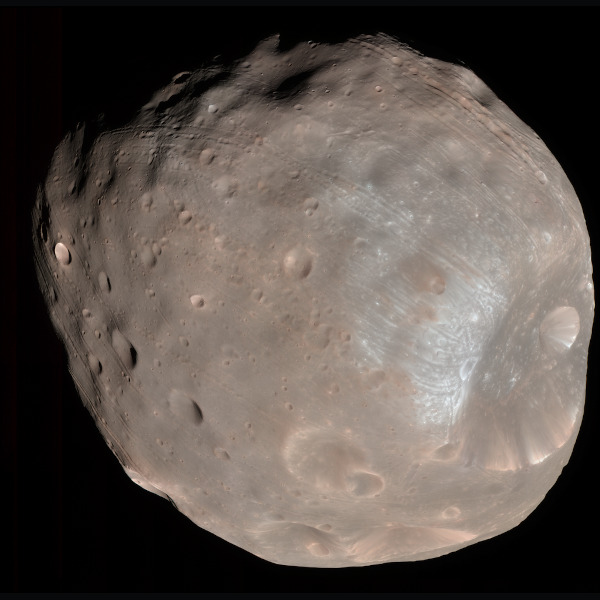
Phobos, the largest of Mars' two moons (about 22 km in average diameter), is doomed to a tragic end. Orbiting only 6,000 km from the Martian surface, it is inexorably approaching the red planet at a rate of 1.8 cm per year (~2 meters per century). This movement is due to tidal forces that transfer energy from Phobos to Mars, gradually altering its orbit. Its small size, about 22 km in average diameter, and its porous composition make its fate particularly fragile against tidal forces.
| Parameter | Value | Unit | Remarks |
|---|---|---|---|
| Semi-major axis | 9,376 | km | Almost circular orbit |
| Orbital period | 0.3189 | days | 7h 39.2m |
| Dimensions | 27 × 22 × 18 | km | Irregular shape |
| Mass | 1.0659 × 1016 | kg | Density ~1.876 g/cm3 |
| Orbital decay | 1.8 | cm/year | Towards Mars |
| Roche limit | ~5,700 | km | Critical distance for breakup |
Observations from the Mars Express probe reveal that Phobos has a low-density internal structure, probably made up of loosely bound rocks and ice. This weak cohesion explains the parallel streaks visible on its surface, precursors to its future breakup.
Calculations show that in about 30 to 50 million years, Phobos will reach Mars' Roche limit \(r = 2.456 \times R_{Mars} \times \left(\frac{\rho_{Mars}}{\rho_{Phobos}}\right)^{1/3}\), the critical distance where tidal forces will exceed the moon's gravitational cohesion. At this stage, Phobos will break up to form a temporary planetary ring around Mars.
| Scenario | Probability | Consequences | Comment |
|---|---|---|---|
| Collision with Mars | Moderate to high | Impact generating a crater tens of km wide | Phobos could collide with Mars in 30 to 50 million years according to orbital measurements |
| Breakup and ring formation | Moderate | Temporary ring around Mars, dispersed over millions of years | Tidal forces could break up the moon before it reaches the surface |
| Temporary stabilization | Low | Maintenance of orbit due to minor gravitational effects | Unlikely but possible scenario over a few million years |